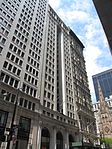Trinity Church (Manhattan)
Trinity Church is a historic parish church in the Episcopal Diocese of New York, at the intersection of Wall Street and Broadway in the Financial District of Lower Manhattan in New York City. Known for its history, location, architecture and endowment, Trinity is a traditional high church, with an active parish centered around the Episcopal Church and the worldwide Anglican Communion in missionary, outreach, and fellowship. In addition to its main facility, Trinity operates two chapels: St. Paul's Chapel, and the Chapel of St. Cornelius the Centurion on Governors Island. The Church of the Intercession, the Trinity Chapel Complex and many other of Anglican congregations in Manhattan were part of Trinity at one point. The current building is the third constructed for Trinity Church, and was designed by Richard Upjohn in the Gothic Revival style. The first Trinity Church building was a single-story rectangular structure facing the Hudson River, which was constructed in 1698 and destroyed in the Great New York City Fire of 1776. The second Trinity Church was built facing Wall Street and was consecrated in 1790. The current church building was erected from 1839 to 1846 and was the tallest building in the United States until 1869, as well as the tallest in New York City until 1890. In 1876–1877 a reredos and altar were erected in memory of William Backhouse Astor Sr., to the designs of architect Frederick Clarke Withers, who extended the rear. The church building is adjacent to the Trinity Churchyard, one of three used by the church. Besides its building, Trinity manages real estate properties with a combined worth of over $6 billion as of 2019. Trinity's main building is a National Historic Landmark as well as a New York City designated landmark. It is also a contributing property to the Wall Street Historic District, a NRHP district created in 2007.
Excerpt from the Wikipedia article Trinity Church (Manhattan) (License: CC BY-SA 3.0, Authors).Trinity Church (Manhattan)
Broadway, New York Manhattan
Geographical coordinates (GPS) Address Website External links Nearby Places Show on map
Geographical coordinates (GPS)
| Latitude | Longitude |
|---|---|
| N 40.708055555556 ° | E -74.012222222222 ° |
Address
Trinity Church
Broadway
10006 New York, Manhattan
New York, United States
Open on Google Maps









